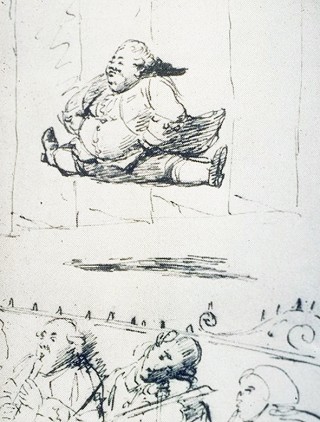Title

In the 17th and 18th centuries, the orchestra was always a partner in some larger project and you could say that the invention of the orchestra in France was really the invention of the Baroque dance band.
On April 12, Juilliard415 and Juilliard Dance present Terpsichore: A Baroque Dance Mix, which features four professional Baroque dancers and four Juilliard dancers. The following is excerpted from the program note by Robert Mealy, the director of Historical Performance, who will also play violin and lead the musicians. The program note can be read in its entirety—along with this year’s other Juilliard programs—at juilliard.edu/program-notes-archive.
Body
Although we think of an orchestra as its own cultural institution today, in the 17th and 18th centuries, the orchestra was always a partner in some larger project, whether with singers in an opera, with a soloist in a concerto, or, as we’re doing this month, with dancers in the ballet. This last form was particularly crucial in France; in fact, you could say that the invention of the orchestra in France was really the invention of the Baroque dance band. The various highly specific patterns of Baroque dance movements remained essential to the French style throughout the 17th and 18th centuries.
The classic story of the French orchestra is that it brings together two institutions of the ancien régime: the royal wind band and the vingt-quatre violons du Roy. But winds only gradually make an appearance in Jean-Baptiste Lully’s operas, and it’s often unclear in many of the midcentury scorings exactly which bits they played, or even what instrument. The classic form of the hautboy, or Baroque oboe, emerged only around 1670, and the transverse flute, or flûte d’Allemagne, only begins to make its appearance in opera bands in the 1680s.
The French fashion for orchestral writing had come over to England when Charles II returned to the throne in 1660. He had spent the Commonwealth years in exile at the court of his cousin Louis XIV, where he developed a taste for French clothes, French food, French art, and French dance music. According to the 18th-century writer Roger North, Charles “could not bear any music to which he could not keep the time [that is, which he couldn’t wave his arms to] which made the common andante or else the step-tripla the only musical styles at Court in his time.”
Although English audiences were interested in these new developments, they drew the line at re-creating full-scale operas in England. Henry Purcell, the greatest English composer of his age, became fascinated with the possibilities that the new French opera offered, and clearly knew many of Lully’s opera scores well. In the last few years of his tragically foreshortened life, Purcell began experimenting with what were called semi-operas, where songs and dances were interspersed with spoken dialogue.
One of his last semi-operas took Dryden’s play King Arthur, or the British Worthy as its libretto. Dryden had written this in 1684 for the 25th anniversary of Charles II’s restoration; he called it a “dramatick opera” where the spoken play would be “adorn’d with Scenes, Machines, Songs, and Dances.” The music we play in this concert is taken from various scenes in the drama.
Also on the program is a suite of dances from one of Lully’s most popular operas, the tragédie-lyrique of Thesée. Many dances from Lully’s operas have come down to us with their period choreographies, and we’re thrilled to bring some of them to life in this concert through the dancing of a quartet of Baroque dancers I’ve collaborated with on many shows over the years.
Where the first half of our program explores the dance music and choreographies of the 17th century, with the second we turn to the 18th century, and more modern styles. We begin with George Frideric Handel’s one major effort in French dance music. The French diva Marie Sallé and her troupe were invited from Paris, and Handel opened his season with a new prologue to Il pastor fido, which featured the muse Terpsichore in a series of dances including a lengthy Chaconne.
We return to France with music from one of Rameau’s most popular operas, Pigmalion. This classic story of the creator who falls in love with his creation is better known in its modern version, My Fair Lady. In Rameau’s version, it is a beautiful statue that comes to life in a very French Baroque way: her initiation into humanity is that she learns to dance.
There is nothing quite as kinetically inspiring in Baroque dance music as the works of Rameau; he is in a way the Stravinsky of the 18th century. According to one famous ballet-master of the time, Claude Gardel, “Rameau perceived what the dancers themselves were unaware of; we thus rightly regard him as our first master.” For this suite, we have called second-year dancer Peter Farrow to create something of his own for himself and some classmates to dance in reaction to this extraordinary music as a counterpoint to the period choreographies we have seen earlier.




